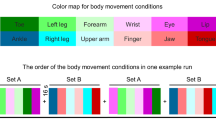Abstract
A comprehensive understanding of the mechanisms that underlie brain development in premature infants and newborns is crucial for the identification of interventional therapies and rehabilitative strategies. fMRI has the potential to identify such mechanisms, but standard techniques used in adults cannot be implemented in infant studies in a straightforward manner. We have developed an MR safe wrist stimulating robot to systematically investigate the functional brain activity related to both spontaneous and induced wrist movements in premature babies using fMRI. We present the technical aspects of this development and the results of validation experiments. Using the device, the cortical activity associated with both active and passive finger movements were reliably identified in a healthy adult subject. In two preterm infants, passive wrist movements induced a well localized positive BOLD response in the contralateral somatosensory cortex. Furthermore, in a single preterm infant, spontaneous wrist movements were found to be associated with an adjacent cluster of activity, at the level of the infant’s primary motor cortex. The described device will allow detailed and objective fMRI studies of somatosensory and motor system development during early human life and following neonatal brain injury.









Similar content being viewed by others
References
Arichi, T., et al. Somatosensory cortical activation identified by functional MRI in preterm and term infants. NeuroImage 49(3):2063–2071, 2010.
Arichi, T., et al. Development of BOLD signal hemodynamic responses in the human brain. NeuroImage 63:663–673, 2012.
AVAGO. HEDS-5701#G00 Datasheet. Accessed 1 October 2011 from http://www.datasheetarchive.com/HEDS-5701-G00*-datasheet.html.
Bandettini, P. A., et al. Time course EPI of human brain function during task activation. Magn. Reson. Med. 25(2):390–397, 1992.
Berns, G. S., A. W. Song, and H. Mao. Continuous functional magnetic resonance imaging reveals dynamic nonlinearities of “dose-response” curves for finger opposition. J. Neurosci. 19(14):RC17, 1999.
Boynton, G. M., et al. Linear systems analysis of functional magnetic resonance imaging in human V1. J. Neurosci. 16(13):4207–4221, 1996.
Dubowitz, L. M. S., V. Dubowitz, and E. Mercuri. The Neurological Assessment of the Preterm & Full-Term Newborn Infant. London: Mac Keith, 1999.
Erberich, S. G., et al. Functional MRI in neonates using neonatal head coil and MR compatible incubator. NeuroImage 20(2):683–692, 2003.
Erberich, S. G., et al. Somatosensory lateralization in the newborn brain. NeuroImage 29(1):155–161, 2006.
FESTO. MPPES Pressure Sensor Datasheet. Accessed 1 October 2011 from http://www.festo.com/net/SupportPortal/Downloads/26930/info_241_en.pdf.
Gassert, R., E. Burdet, and K. Chinzei. Opportunities and challenges in MR-compatible robotics: reviewing the history, mechatronic components, and future directions of this technology. IEEE Eng. Med. Biol. Mag. 27(3):15–22, 2008.
Gassert, R., E. Burdet, and K. Chinzei. MRI-compatible robotics. IEEE Eng. Med. Biol. Mag. 27(3):12–14, 2008.
Heep, A., et al. Functional magnetic resonance imaging of the sensorimotor system in preterm infants. Pediatrics 123(1):294–300, 2009.
Johnston, M. V. Plasticity in the developing brain: implications for rehabilitation. Dev. Disabil. Res. Rev. 15(2):94–101, 2009.
Klingner, C. M., et al. Functional deactivations: multiple ipsilateral brain areas engaged in the processing of somatosensory information. Hum. Brain Mapp. 32(1):127–140, 2011.
Kuang, K. S. C., W. J. Cantwell, and P. J. Scully. An evaluation of a novel plastic optical fibre sensor for axial strain and bend measurements. Meas. Sci. Technol. 13(10):1523–1534, 2002.
Kuehn, B. M. FDA warning: remove drug patches before MRI to prevent burns to skin. JAMA 301(13):1328, 2009.
Larroque, B., et al. Neurodevelopmental disabilities and special care of 5-year-old children born before 33 weeks of gestation (the EPIPAGE study): a longitudinal cohort study. Lancet 371(9615):813–820, 2008.
Mangham, L. J., et al. The cost of preterm birth throughout childhood in England and Wales. Pediatrics 123(2):e312–e327, 2009.
Martin, J. A., et al. Births: final data for 2004. Natl Vital Stat. Rep. 55(1):1–101, 2006.
Martin, J. A., et al. Births: final data for 2005. Natl Vital Stat. Rep. 56(6):1–103, 2007.
Martin, J. A., et al. Births: final data for 2007. Natl Vital Stat. Rep. 58(24):1–85, 2010.
Measurand. S720 MINIATURE JOINT ANGLE ShapeSensor, 2010. Accessed 1 October 2011 from http://www.measurand.com/manuals/S720.pdf.
Merchant, N., et al. A patient care system for early 3.0 Tesla magnetic resonance imaging of very low birth weight infants. Early Hum. Dev. 85(12):779–783, 2009.
National Instruments Corporation. NI USB-6211 DATASHEET. NI USB-6211 16-Bit, 250 kS/s M Series Multifunction DAQ, Bus-Powered Online Datasheet, 2012. Accessed 20 February 2012 from http://sine.ni.com/nips/cds/print/p/lang/en/nid/203224.
Ogawa, S., et al. Brain magnetic resonance imaging with contrast dependent on blood oxygenation. Proc. Natl. Acad. Sci. U.S.A. 87(24):9868–9872, 1990.
PAR-Group. ABS Technical Information. PAR Group-ABS Technical Information, 2011. Accessed 1 October 2011 from http://www.par-group.co.uk/UserDocs/Plastics%20-%20Technical/ABS.pdf.
Seghier, M. L., and P. S. Huppi. The role of functional magnetic resonance imaging in the study of brain development, injury, and recovery in the newborn. Semin. Perinatol. 34(1):79–86, 2010.
Staple, D. Lego Pneumatic Specifications. 2005 Tuesday 18 of January, 2005 16:03:33 GMT, 2005. Accessed 1 October 2011 from http://orionrobots.co.uk/Lego+Pneumatic+Specifications.
Staudt, M. Brain plasticity following early life brain injury: insights from neuroimaging. Semin. Perinatol. 34(1):87–92, 2010.
Van Dijk, K. R., M. R. Sabuncu, and R. L. Buckner. The influence of head motion on intrinsic functional connectivity MRI. NeuroImage 59(1):431–438, 2012.
Zhang, N., et al. Dependence of BOLD signal change on tactile stimulus intensity in SI of primates. Magn. Reson. Imaging 25(6):784–794, 2007.
Acknowledgments
This study was funded in full by a Biomedical Research Center (BRC) project grant. AA was supported by a PhD studentship from the Engineering and Physical Sciences Research Council (EPSRC) UK. TA was supported by a fellowship from the Medical Research Council (MRC) UK. The authors thank Dr Nathanael Jarrassé, Dr Sivakumar Balasubramanian, and Dr Nicholas Roach for their technical assistance throughout the development of the device, Ms Joanna Allsop for her contribution during the experimental phase of the study, Mr Richard Woodward and the parents of the patients for agreeing participation in the study.
Author information
Authors and Affiliations
Corresponding author
Additional information
Associate Editor Xiaoxiang Zheng oversaw the review of this article.
Rights and permissions
About this article
Cite this article
Allievi, A.G., Melendez-Calderon, A., Arichi, T. et al. An fMRI Compatible Wrist Robotic Interface to Study Brain Development in Neonates. Ann Biomed Eng 41, 1181–1192 (2013). https://doi.org/10.1007/s10439-013-0782-x
Received:
Accepted:
Published:
Issue Date:
DOI: https://doi.org/10.1007/s10439-013-0782-x




